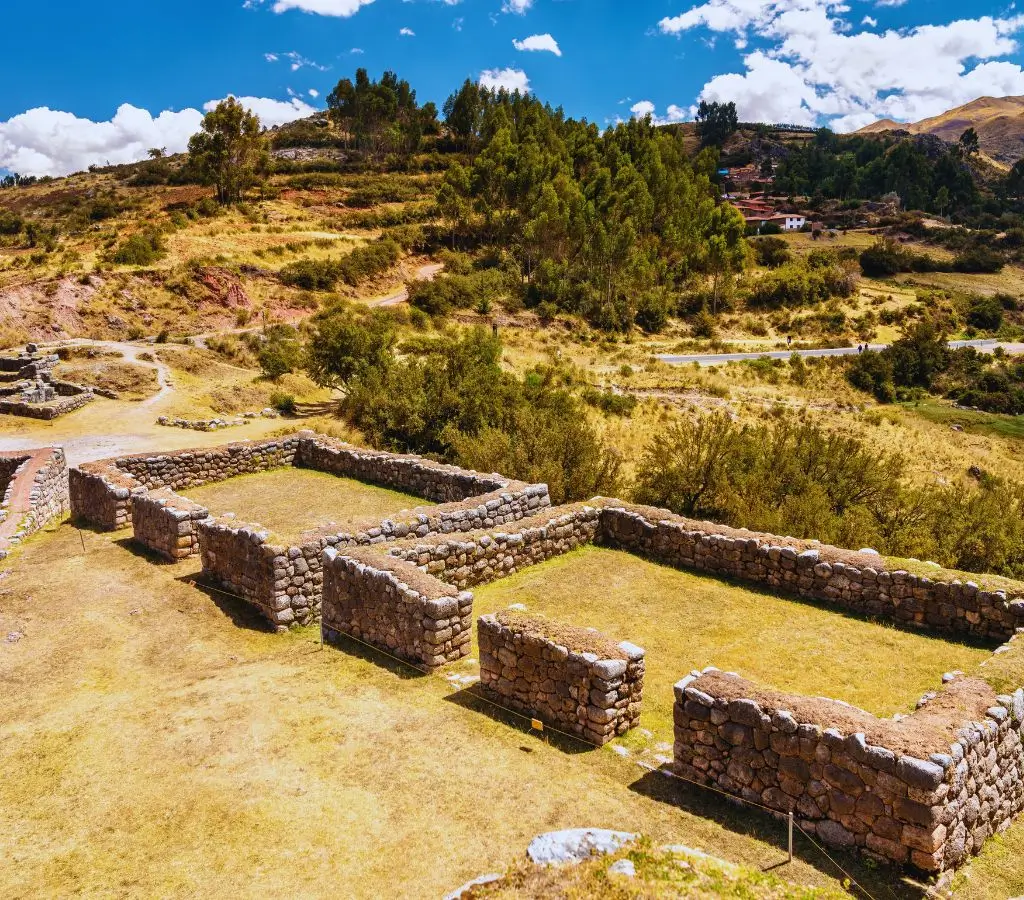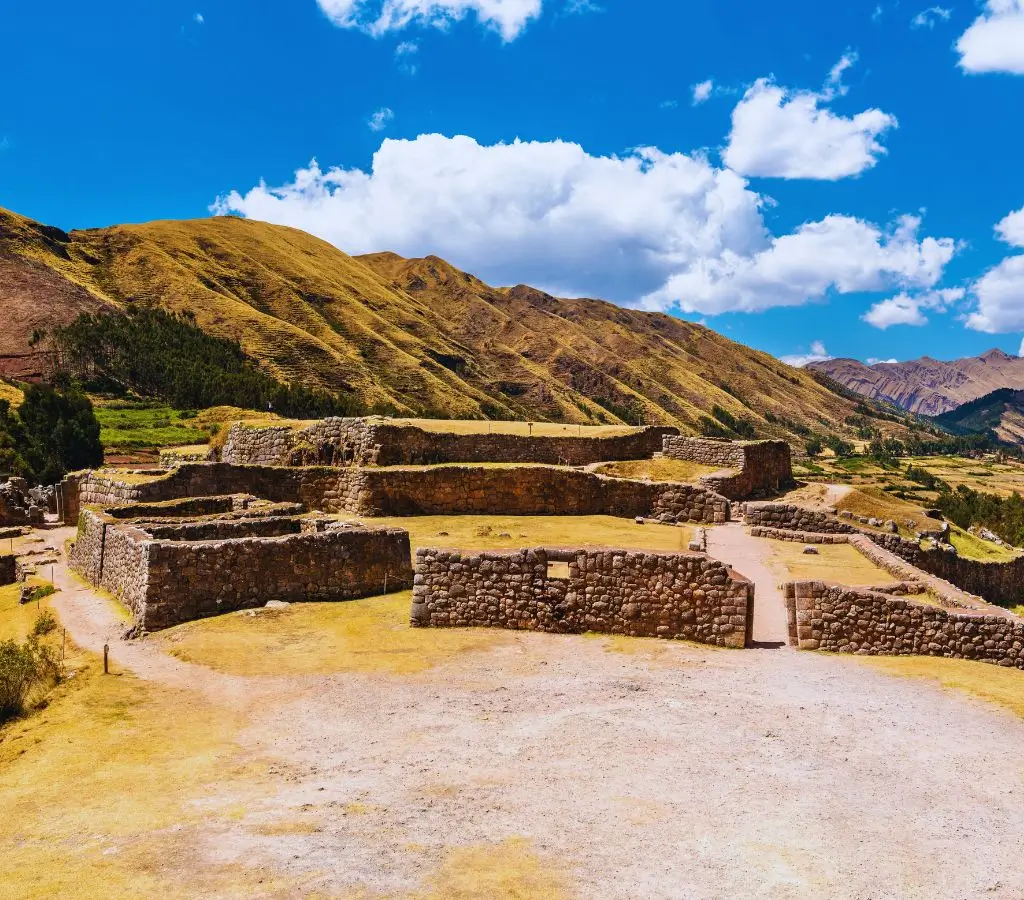Beyond the grand Sacsayhuamán Archaeological Park, we encounter the Puka Pukara Archaeological Center, an ancestral relic that transports us to forgotten times of the Inca Empire. This construction narrates the story of a glorious past through its ancient stones. Puka Pukara is not merely a set of ruins; it is a living testament to the ingenuity and grandeur of a civilization lost in time. Every corner, every wall, whispers secrets that awaken the imagination and invite us to explore a world full of mystery and wonder.
The name "Puka Pukara" derives from the Quechua language, where "Puka" means "red" and "Pukara" translates to "fortress" or "fortified place." Therefore, Puka Pukara is commonly interpreted as "Red Fortress." This name arises from the reddish pigment on the walls of the fortress.
There isn't much information about this Inca site; however, according to specialists, the site is referred to as a military fortress due to its structures and construction style. Some suggest that it possibly served as a resting and control point for travelers heading to or from Cusco, as well as for the messengers known as "chasquis." Furthermore, its strategic location within the Inca road network, the "Qhapaq Ñan," suggests an important role in history.
At the heart of this construction lies a chinkana, an intriguing cave that fuels local legends. It is said that these caves connected different Inca sites, and there is speculation that the Puka Pucara chinkana could have been linked to Tambomachay, although this theory remains unconfirmed. Thus, Puka Pukara remains a fascinating enigma that invites us to ponder the past and mystery of the Inca empire.
The name "Puka Pukara" translates as "Red Fortress" in Quechua, owing to the reddish color in which it was constructed.
Regarding the spelling "Puca Pucará" or "Puka Pukara," it is due to the variation in Quechua grammar across regions; however, both terms refer to the same fortress located in Cusco.
The exact function of Puka Pukara remains a subject of debate among archaeologists and scholars, as some suggest it was a military control post, designed to protect the entrance to Cusco and oversee movements in the region.
Others argue that it could have been a resting and accommodation site for travelers and dignitaries heading to the empire's capital. The combination of defensive structures and residential areas suggests that Puka Pukara may have served multiple functions over time.

Puka Pukara is strategically located near Cusco, its construction atop a hill provides a panoramic view of the surrounding valleys, making it a lookout and observation point.
It is characterized by its construction of stone, with a predominance of reddish color throughout the archaeological area. The fortress is surrounded by stone walls, watchtowers, and terraces, suggesting meticulous planning and a defensive design.
Additionally, evidence of water systems and possible residential areas has been found, indicating a multifaceted function of the site.
The architecture of Puka Pukara is impressive; constructed of medium and small stones, it ensured perfect support against earthquakes or other natural activities. However, it's important to remember that these sites lost their original form after the arrival of the Spanish.

One of the most intriguing aspects of Puka Pukara is the presence of a structure known as "The Chincana." This labyrinth of narrow passageways and interconnected rooms has puzzled archaeologists for years. It is speculated that it could have served as a ceremonial site, a storage center, or even a safe refuge in times of conflict.
Located at the base of the fortress, this structure is stable and its design is serpentine; towards the north, there are six rooms of various sizes, while to the west extends a trapezoidal-shaped plaza. Originally, this square was surrounded by buildings on both sides and at one end, the road intersects with the Qhapac Ñan.
The second wall of Puka Pukara, although less imposing than the first, remains an integral part of the site's defense. This inner wall protected specific areas within the fortress and could have served as an additional barrier in case of enemy attack.
One must enter through wide stone stairways with terraces and gardens oriented towards the south and east to Puca Pucara. Here, three rooms are found, one rectangular and another trapezoidal in shape. You'll also notice that the walls are built of medium and small limestone stones, with a slight anti-seismic inclination that has allowed them to withstand several earthquakes over time.
The third wall of Puka Pukara did exist, although there are no traces of its buildings. Specialists suggest that the constructions here were of lower quality than those of the previous walls.

To reach Puka Pukara from Cusco, visitors have several options.
A convenient option is to take a taxi from Cusco to Puka Pukara. Taxis are readily available and offer flexibility in terms of schedule and route. However, it's important to agree on the price with the driver before starting the journey.
Another alternative is to join a tour like those offered by Illapa Culturas Andinas, which provide transportation and expert guides offering detailed information about the site and its history. Traveling with them is one of the safest modalities, and you no longer have to worry about mobility or where to eat.
City Tour in Cusco, this allows you to reach Puca Pucará, and you can also go to Sacsayhuaman, Qenqo, Tambomachay places you can visit.
Puka Pukara Before visiting Puka Pukara, it is important to consider some practical details:
The site is open to the public every day of the week from 7 am to 6 pm. Entrance tickets can be purchased onsite or through authorized tourism agencies; in this case, you can acquire your Integral Tourist Ticket (BTCI) or Partial Tourist Ticket (BTP), each with a different cost and allowing you to visit specific sites, also with a duration time.
Some recommendations for a pleasant visit include: bringing water, sunscreen, and comfortable walking clothes. Additionally, it is important to respect the site's indications and restrictions to preserve its historical and natural integrity.
In conclusion, Puka Pukara is much more than a simple fortress; it is a tangible testimony to the ingenuity and creativity of the Inca civilization. Its history, architecture, and mysteries continue to captivate visitors from around the world, offering a fascinating window into Peru's past. To continue discovering more tourist attractions in Cusco, travel with Illapa Culturas Andinas, an experienced agency certified by the Peruvian state.

